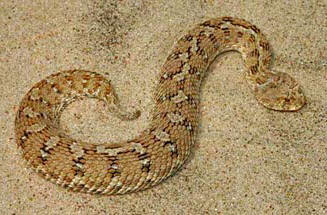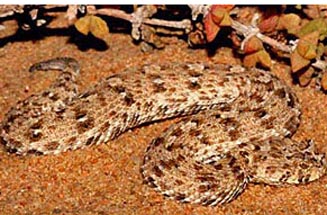|
Bitis schneideri (Namaqua dwarf adder)
Namakwadwergadder [Afrikaans]
Life >
Eukaryotes
>
Opisthokonta >
Metazoa
(animals) > Bilateria > Deuterostomia >
Chordata >
Craniata > Vertebrata (vertebrates) > Gnathostomata (jawed vertebrates) >
Teleostomi (teleost fish) > Osteichthyes (bony fish) > Class:
Sarcopterygii (lobe-finned fish) > Stegocephalia (terrestrial vertebrates) >
Tetrapoda
(four-legged vertebrates) > Reptiliomorpha > Amniota >
Reptilia (reptiles) >
Romeriida > Diapsida > Lepidosauromorpha > Lepidosauria >
Squamata > Serpentes
(snakes) > Family: Viperidae > Genus:
Bitis
|

Bitis schneideri (Namaqua dwarf adder),
Northern Cape [C. Dorse & S Van Rooyen © from
SARCA
Virtual Museum] |
 Bitis schneideri
(Namaqua dwarf adder), Northern Cape [B. Maritz
©
from
SARCA
Virtual Museum]
|
Identification
This adder species can be identified by its grey or grey
brown colour, its 3 series of pale centered dark spots down the length of its
body, its keeled (rough) scales, dark tipped tail and small size (it is the
smallest adder in the world); It has an average length of 20 cm but may reach 28
cm in length.
Distribution and habitat
The Namaqua dwarf adder is only found in the extreme north-western corner of the Northern Cape and the
south-western corner of Namibia. Its
favoured habitat is vegetated coastal sand dunes in the Western Karoo and Namib
desert.
Food
Feeds on lizards (including skinks, lacertids and geckos),
small mammals
(e.g. rats and
mice)
and
amphibians (e.g.
frogs
and toads).
Predators, parasites and disease
The biggest threat is habitat destruction associated with
diamond mining.
Reproduction
Viviparous (gives birth to live young); three to seven young
are born in late summer.
Longevity
Has an average lifespan of 10 years.
Medical importance
Has a weak cytotoxic venom that causes
pain and swelling, Antivenom is unnecessary.
Links
References
-
Broadley, D.G. 1983. FitzSimons' Snakes of Southern
Africa. Delta Books, Johannesburg.
-
Marais, J. 2004. A Complete Guide to Snakes of Southern Africa.
Struik Publishing, Cape Town.
|
